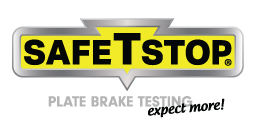There are 4 ways you can really TEST brakes – how much do you know?
First Test Method
The first and most basic of the brake testing methods is the ADR (Australian Design Rules) compliance test. This test is a minimum standard and must be passed by every vehicle built or imported into Australia. The test involves measuring the distance it takes to stop – 100 km/h to a standstill. While this may be a standard, it is not always a practical test to perform.
Second Test Method
The second test method is the decelerometer, which requires the vehicle to be driven on a public road, usually at about 35 km/h. When the brakes are applied, the decelerometer measures the braking of the vehicle with a pendulum action. This test must be done on a road, which can be risky in the wet – or in a vehicle which may have faults unknown to the technician taking it for a road test. The road used for the test must be designated by the police, and this can be extremely annoying to local residents.
Both these methods can tell you a vehicle will stop, in a very basic way, but they are imprecise and they don’t show the amount of braking effort of individual wheels. They also don’t show imbalances which can cause a vehicle to spin or to perform unpredictably in an emergency.
Third Test Method
The third method of testing brakes is the roller tester. Each wheel is tested with this equipment, and braking is measured by the roller when the vehicle brakes are applied.
Fourth Test Method
The last method is the plate brake test. Let’s look at the SafeTstop – which simulates a stretch of road with sensors underneath, and it measures the vehicle’s braking performance exactly as it would behave on the road. It allows you to determine how a vehicle will respond in an emergency braking situation, by showing each wheel’s brake performance. It also gives tyre drag measurements, and has a weighbridge function for testing corner weights, axle weights and suspension testing.
The sensors in the SafeTstop plate brake tester are extremely sensitive, and they will measure the force of a finger through to 1 tonne of braking effort. The tester measures each wheel’s braking in Newton. By looking at the test results, we can see imbalances or measurements indicating issues such as seized calipers and broken brake hoses, master cylinder problems and proportioning valves that are not working. Many of these issues would not be found on a road brake test.
Of course, a vehicle’s brakes are not pulled apart at every service, so the only indication of imbalances may be pad wear. But how long will it be before you notice you have replaced three sets of brake pads on the front and none on the back, and then you find there is a major brake imbalance?
Safe, Easy & Quick To Use
SafeTstop takes less than a minute to do a test, and it prints a report of every test. The test report is designed for you to hand over to the customer, with graphics explaining the test. It includes photo proof of the vehicle tested – your customer then knows you tested their car – which builds trust and loyalty. Most workshops with SafeTstop charge $20-$30 for this test, and if you do the math, putting every car over the SafeTstop and charging for that test, you have a big boost to your income.
A SafeTstop can be installed indoors or out (it’s weatherproof) and it sits on a flat concrete surface (your workshop floor or driveway). It can be installed into the floor, but this is not necessary. It doesn’t need to take up any space – most are in the workshop entry – because it can be treated like the floor – park on it, drive across it on the way to a hoist, whatever. Anything under 4.5 tonnes is fine to drive over it. SafeTstop makes a useless area of floor into a money-earner.
But the best thing about working with SafeTstop is the knowledge that it’s a win-win. You earn more, your work is more efficient and more professional, and your customers are safer. Expect more!
Contact us now to find out more about plate brake testing.

